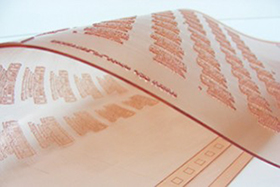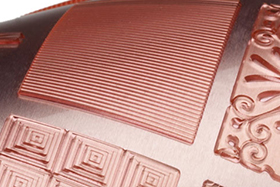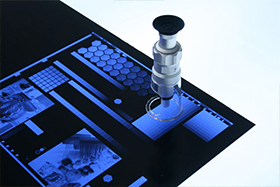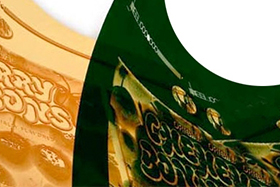Flexography
(often abbreviated to flexo) is a form of printing process which utilizes a flexible relief plate. It is essentially a modern version of letterpress which can be used for printing on almost any type of substrate, including plastic, metallic films, cellophane, and paper. It is widely used for printing on the non-porous substrates required for various types of food packaging (it is also well suited for printing large areas of solid color).
History
In 1890, the first such patented press was built in Liverpool, England by Bibby, Baron and Sons. The water-based ink smeared easily, leading the device to be known as "Bibby's Folly". In the early 1900s, other European presses using rubber printing plates and aniline oil-based ink were developed. This led to the process being called "aniline printing". By the 1920s, most presses were made in Germany, where the process was called "gummidruck," or rubber printing. In modern-day Germany, they continue to call the process "gummidruck."
During the early part of the 20th century, the technique was used extensively in food packaging in the United States. However, in the 1940s, the Food and Drug Administration classified aniline dyes as unsuitable for food packaging. Printing sales plummeted. Individual firms tried using new names for the process, such as "Lustro Printing" and "Transglo Printing," but met with limited success. Even after the Food and Drug Administration approved the aniline process in 1949 using new, safe inks, sales continued to decline as some food manufacturers still refused to consider aniline printing. Worried about the image of the industry, packaging representatives decided the process needed to be renamed.
In 1951 Franklin Moss, then the president of the Mosstype Corporation, conducted a poll among the readers of his journal The Mosstyper to submit new names for the printing process. Over 200 names were submitted, and a subcommittee of the Packaging Institute's Printed Packaging Committee narrowed the selection to three possibilities: "permatone process", "rotopake process", and "flexographic process". Postal ballots from readers of The Mosstyper overwhelmingly chose the last of these, and "flexographic process" was chosen.
Evolution
Originally, flexographic printing was rudimentary in quality. Labels requiring high quality have generally been printed using the offset process until recently. Since 1990, great advances have been made to the quality of flexographic printing presses, printing plates and printing inks. The greatest advances in flexographic printing have been in the area of photopolymer printing plates, including improvements to the plate material and the method of plate creation. Digital direct to plate systems have been a good improvement in the industry recently with advances in fast washout and the latest screening technology. Laser-etched ceramic anilox rolls also play a part in the improvement of print quality. Full-color picture printing is now possible, and some of the finer presses available today, in combination with a skilled operator, allow quality that rivals the lithographic process. One ongoing improvement has been the increasing ability to reproduce highlight tonal values, thereby providing a workaround for the very high dot gain associated with flexographic printing.
Article is taken from Wikipedia.





